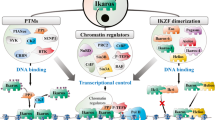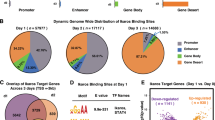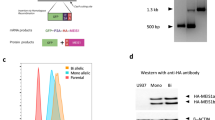Abstract
Although most Ets transcription factors have been characterized as transcriptional activators, some of them display repressor activity. Here we characterize an Ets-family member, the very specifically expressed human Fifth Ewing Variant (FEV), as a transcriptional repressor. We show that among a broad range of human cell lines, only Dami megakaryocytic cells express FEV. This nuclear protein binds to Ets-binding sites, such as that of the human ICAM-1 promoter. We used this promoter to demonstrate that FEV can repress both basal transcription and, even more strongly, ectopically Ets-activated transcription. We identified two domains responsible for FEV-mediated repression: the ETS domain, responsible for passive repression, and the carboxy-terminal alanine-rich domain, involved in active repression. In the Ets-independent LEXA system also, FEV acts as a transcriptional repressor via its alanine-rich carboxy-terminal domain. The mechanism by which FEV actively represses transcription is currently unknown, since FEV-triggered repression is not reversed by the histone deacetylase inhibitor trichostatin A. We also showed that long-term overexpression of FEV proteins containing the alanine-rich domain prevents cell clones from growing, whereas clones expressing a truncated FEV protein lacking this domain develop like control cells. This confirms the importance of this domain in FEV-triggered repression.
This is a preview of subscription content, access via your institution
Access options
Subscribe to this journal
Receive 50 print issues and online access
$259.00 per year
only $5.18 per issue
Buy this article
- Purchase on Springer Link
- Instant access to full article PDF
Prices may be subject to local taxes which are calculated during checkout







Similar content being viewed by others
References
Baert JL, Beaudoin C, Coutte L and de Launoit Y . (2002). J. Biol. Chem., 277, 1002–1012.
Baert JL, Monte D, Musgrove EA, Albagli O, Sutherland RL and de Launoit Y . (1997). Int. J. Cancer, 70, 590–597.
Bird AP and Wolffe AP . (1999). Cell, 99, 451–454.
Briata P, Ilengo C, Van DeWerken R and Corte G . (1997). FEBS Lett., 402, 131–135.
Chakrabarti SR and Nucifora G . (1999). Biochem. Biophys. Res. Commun., 264, 871–877.
Courey AJ and Jia S . (2001). Genes Dev., 15, 2786–2796.
Coutte L, Monte D, Imai K, Pouilly L, Dewitte F, Vidaud M, Adamski J, Baert JL and de Launoit Y . (1999). Oncogene, 18, 6278–6286.
Criqui-Filipe P, Ducret C, Maira SM and Wasylyk B . (1999). EMBO J., 18, 3392–3403.
de Launoit Y, Audette M, Pelczar H, Plaza S and Baert JL . (1998). Oncogene, 16, 2065–2073.
de Launoit Y, Chotteau-Lelievre A, Beaudoin C, Coutte L, Netzer S, Brenner C, Huvent I and Baert JL . (2000). Adv. Exp. Med. Biol., 480, 107–116.
Defossez PA, Baert JL, Monnot M and de Launoit Y . (1997). Nucleic Acids Res., 25, 4455–4463.
Ducret C, Maira SM, Lutz Y and Wasylyk B . (2000). Oncogene, 19, 5063–5072.
Fenrick R, Amann JM, Lutterbach B, Wang L, Westendorf JJ, Downing JR and Hiebert SW . (1999). Mol. Cell. Biol., 19, 6566–6574.
Fyodorov D, Nelson T and Deneris E . (1998). J. Neurobiol., 34, 151–163.
Goodman FR, Mundlos S, Muragaki Y, Donnai D, Giovannucci-Uzielli ML, Lapi E, Majewski F, McGaughran J, McKeown C, Reardon W, Upton J, Winter RM, Olsen BR and Scambler PJ . (1997). Proc. Natl. Acad. Sci. USA, 94, 7458–7463.
Graves BJ and Petersen JM . (1998). Adv. Cancer Res., 75, 1–55.
Guidez F, Petrie K, Ford AM, Lu H, Bennett CA, MacGregor A, Hannemann J, Ito Y, Ghysdael J, Greaves M, Wiedemann LM and Zelent A . (2000). Blood, 96, 2557–2561.
Hanna-Rose W and Hansen U . (1996). Trends Genet., 12, 229–234.
Hendricks T, Francis N, Fyodorov D and Deneris ES . (1999). J. Neurosci., 19, 10348–10356.
Janknecht R . (1996). Mol. Cell. Biol., 16, 1550–1556.
Janknecht R, Monte D, Baert JL and de Launoit Y . (1996). Oncogene, 13, 1745–1754.
Karim FD, Urness LD, Thummel CS, Klemsz MJ, McKercher SR, Celada A, Van Beveren C, Maki RA, Gunther CV, Nye JA and Graves BJ . (1990). Genes Dev., 4, 1451–1453.
Laget MP, Defossez PA, Albagli O, Baert JL, Dewitte F, Stehelin D and de Launoit Y . (1996). Oncogene, 12, 1325–1336.
Lemercier C, Verdel A, Galloo B, Curtet S, Brocard MP and Khochbin S . (2000). J. Biol. Chem., 275, 15594–15599.
Li R, Pei H, Watson DK and Papas TS . (2000). Oncogene, 19, 745–753.
Lopez RG, Carron C, Oury C, Gardellin P, Bernard O and Ghysdael J . (1999). J. Biol. Chem., 274, 30132–30138.
Maira SM, Wurtz JM and Wasylyk B . (1996). EMBO J., 15, 5849–5865.
Maroulakou IG and Bowe DB . (2000). Oncogene, 19, 6432–6442.
Mavrothalassitis G and Ghysdael J . (2000). Oncogene, 19, 6524–6532.
Monte D, Baert JL, Defossez PA, de Launoit Y and Stehelin D . (1994). Oncogene, 9, 1397–1406.
Monte D, Coutte L, Baert JL, Angeli I, Stehelin D and de Launoit Y . (1995). Oncogene, 11, 771–779.
O'Neill EM, Rebay I, Tjian R and Rubin GM . (1994). Cell, 78, 137–147.
Peter M, Couturier J, Pacquement H, Michon J, Thomas G, Magdelenat H and Delattre O . (1997). Oncogene, 14, 1159–1164.
Pfaar H, von Holst A, Vogt Weisenhorn DM, Brodski C, Guimera J and Wurst W . (2002). Dev. Genes Evol., 212, 43–46.
Ray-Gallet D, Mao C, Tavitian A and Moreau-Gachelin F . (1995). Oncogene, 11, 303–313.
Sgouras DN, Athanasiou MA, Beal Jr GJ, Fisher RJ, Blair DG and Mavrothalassitis GJ . (1995). EMBO J., 14, 4781–4793.
Sharrocks AD . (2001). Nat. Rev. Mol. Cell. Biol., 2, 827–837.
Sieweke MH, Tekotte H, Frampton J and Graf T . (1996). Cell, 85, 49–60.
Xing X, Wang SC, Xia W, Zou Y, Shao R, Kwong KY, Yu Z, Zhang S, Miller S, Huang L and Hung MC . (2000). Nat. Med., 6, 189–195.
Yeung KC, Inostroza JA, Mermelstein FH, Kannabiran C and Reinberg D . (1994). Genes Dev., 8, 2097–2109.
Acknowledgements
PM and FT should be considered to be the first authors. This paper is dedicated to the late Rudy Deschuyteneer. We thank to Pascale Putmans for her excellent technical assistance. PM and CB are recipients of a ‘Télévie’ grant (FNRS, Belgium). FT is a recipient of an FRIA grant (FNRS, Belgium). This work was carried out, thanks to grants awarded by the ‘Centre National de la Recherche Scientifique. (France), the ‘Institut Pasteur de Lille’, the ‘Association pour la Recherche contre le Cancer’ (France), the ‘Ligue Régionale Contre le Cancer’ (Comité Nord, France), the ‘Fonds National de la Recherche Scientifique’ (FNRS, Belgium), and the ‘Action de Recherche Concertée (Communauté Françhise de Belgique)’ (Belgium).
Author information
Authors and Affiliations
Corresponding author
Rights and permissions
About this article
Cite this article
Maurer, P., T'Sas, F., Coutte, L. et al. FEV acts as a transcriptional repressor through its DNA-binding ETS domain and alanine-rich domain. Oncogene 22, 3319–3329 (2003). https://doi.org/10.1038/sj.onc.1206572
Received:
Revised:
Accepted:
Published:
Issue Date:
DOI: https://doi.org/10.1038/sj.onc.1206572
Keywords
This article is cited by
-
The expression of the transcription factor FEV in adult human brain and its association with affective disorders
Journal of Neural Transmission (2010)
-
The 26S proteasome system degrades the ERM transcription factor and regulates its transcription-enhancing activity
Oncogene (2007)
-
Ets-1 expression promotes epithelial cell transformation by inducing migration, invasion and anchorage-independent growth
Oncogene (2005)



